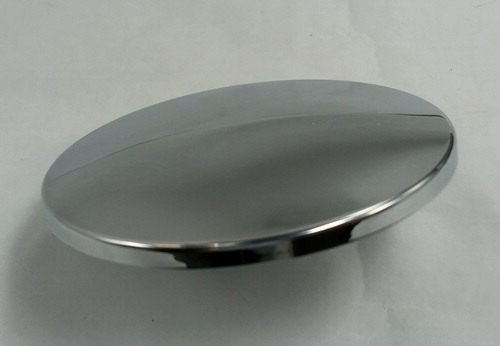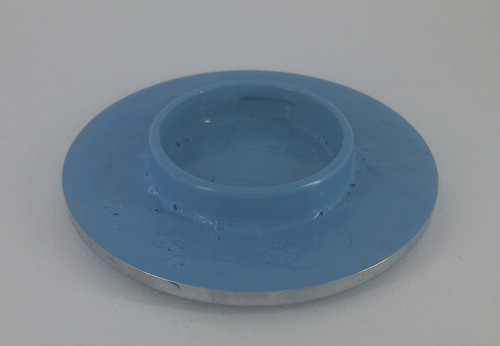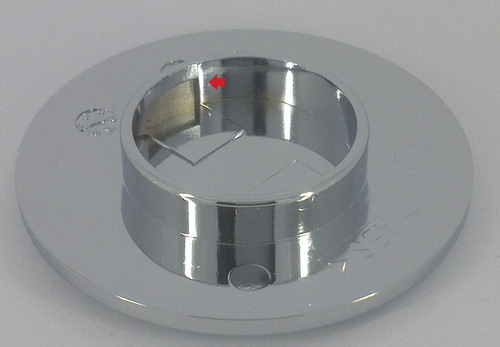‘Nickel Allergy’ arises when some nickel-containing articles are in prolonged and direct contact with skin, causing corrosion of elemental nickel by sweat and liberating sufficient nickel ions to be absorbed through the skin, resulting in an immune reaction in the form of allergic contact dermatitis (ACD). The EU ‘Nickel Restrictions’ legislation imposes limits on the amount of nickel released from articles intended to come into direct and prolonged contact with skin, but permitting a non-nickel surface coating that can ensure the rate of nickel release does not exceed 0.5 μg/cm2/week after two years of normal use. Tests for qualification are EN 12472 and EN 1811.
A program of testing was undertaken to determine nickel release rates from electroplated bright nickel-chromium coatings, with and without UV cured clear protective top coats suitable for use on moulded ABS plastics substrates. Regular chromium deposited from a hexavalent electrolyte was used as the benchmark, with microporous chromium, electrophoretic and sprayed Sol-gel coatings evaluated for potentially improved performance. While all these coating combinations over bright nickel significantly decreased nickel release, regular (conventional) chromium was the coating of choice, given its ready availability worldwide, and lowest cost.
Recognising environmental constraints on hexavalent chromium in Europe and other countries, substitution by trivalent chromium was reviewed and pointers identified for the selection of commercial processes that will provide a regular chromium deposit with suitable protection over bright nickel.
Keywords: Nickel allergy, Nickel restrictions, Acquired Contact Dermatitis, Nickel release rates, EN 1811:2011
Background
A number of chemicals containing nickel can cause Allergic Contact Dermatitis (ACD), appearing as a rash, itch, redness or dry skin in nickel-sensitised persons. Often referred to as ‘Nickel Allergy’, it arises when some nickel-containing items are in prolonged and direct contact with skin, causing corrosion of nickel and the liberation of nickel ions sufficient to be absorbed through the skin, resulting in an immune reaction in the form of ACD.The rate of nickel release is dependent on the article that has contact with the skin, and varies with individuals.
Nickel ACD is not inherited. It arises from prolonged and direct skin exposure, causing the immune system to become nickel-sensitised if enough nickel ions are absorbed through the skin in the same area. Once affected, exposure to sufficient amounts of nickel ions can cause nickel-allergic reactions. While the symptoms dissipate after the exposure source of nickel ions is removed, nickel ACD may reoccur with further sufficient nickel ion exposure.
The incidence of non-occupational sensitisation was first reported from skin contact with nickel plated haberdashery items such as clothing hooks, clasps and zippers. Nowadays it most commonly originates from costume jewellery and body piercing.
In 1994, the EU issued the ‘Nickel Directive’, a regulatory control that imposes limits on the amount of nickel released from articles intended to come into direct and prolonged contact with the skin. In 2007, that was subsumed into the EU Commission Regulation on Registration, Evaluation, Authorisation and Restriction of Chemicals (REACH), Annex XVII, Item 27, which documents “Restrictions on the manufacture, placing on the market and use of certain dangerous substances, preparations and articles”. It states, nickel:
| 1. | 1. Shall not be used:
| ||||||||||||||||||||||
| 2. | Articles which are the subject of paragraph 1, shall not be placed on the market unless they conform to the requirements set out in those points. | ||||||||||||||||||||||
| 3. | The standards adopted by the European Committee for Standardisation (CEN) shall be used as the test methods for demonstrating the conformity of articles to paragraphs 1 and 2. | ||||||||||||||||||||||
Introduction
This project set out to evaluate the performance of coatings that would enable bright nickel-chromium electroplated coatings to be used for consumer products without fear of nickel release, as defined in the above EU ‘Nickel Restrictions’.
While both metal and plastics substrates find wide application for decorative nickel-chromium plated articles, this work has been designed to focus on ABS plastics mouldings only, on the premise that if a satisfactory coating is workable for plated plastics (where elevated temperature and consequent distortion must be avoided), it will be equally applicable to metallic substrates. ABS moulded specimens were plated with copper, bright nickel and chromium ().
Many manufacturers of consumer products are concerned about the potential for nickel release from nickel-chromium plated products intended for the European market, and in consequence attention has been given to redesign of articles, review of materials selection and the introduction of alternative surface finishing methods.Citation1,Citation2
It may be noted that analogous behaviour has been known for several decades to occur with flash gold coatings over nickel underlayers for similar consumer products, but these will not be considered here.Citation3
The purpose of this project was to benchmark regular (conventional) bright nickel-chromium coatings, and possibly enhance their resistance to nickel release by substituting a more advanced chromium deposit, or by application of a protective top coat.
Experimental
ABS moulded test pieces plated with bright copper and nickel were prepared with different chromium and protective top coats. All plating was carried out in proprietary baths under operating conditions recommended by the process supplier.
Worldwide, deposition from a hexavalent electrolyte is the most common chromium top coat for decorative bright nickel. Six (6) specimen groups had this coating - three (3) with regular chromium and three (3) with microporous chromium. Each group had uncoated chromium electroplate as a reference; one set with a clear UV cured cathodic electrophoretic coating and another with a clear UV cured sprayed silica based nano-coating (Sol-gel).
After testing all six (6) sets of specimens in triplicate, it was found the top coats and microporous chromium performed no better than uncoated regular (conventional) chromium deposited from a hexavalent electrolyte. But in Europe and some other countries, hexavalent chromium is being phased outCitation4 and is being replaced by deposition from trivalent chromium electrolytes. Accordingly, one set of specimens was prepared with trivalent chromium alone, since tests with hexavalent deposits showed microporous chromium and organic top coats conferred no special benefit.
Thus, seven (7) specimen sets were prepared in triplicate. Total: 21 test specimens.
(A) Regular hexavalent Cr only.
(B) Regular hexavalent Cr, plus clear UV cured electrophoretic coating.
(C) Regular hexavalent Cr, plus sprayed clear UV cured Sol-gel coating.
(D) Microporous hexavalent Cr.
(E) Microporous hexavalent Cr, plus clear UV cured electrophoretic coating.
(F) Microporous hexavalent Cr, plus sprayed clear UV cured Sol-gel coating.
(G) Regular trivalent Cr from a chloride electrolyte.
Table 1. Rate of nickel release from specimens A to G in triplicate
For microporous chromium, the specified minimum of 10,000 pores cm− 2 was verified using the copper deposition method (Dubpernell Test) described in Annex E of ISO 4525:2003
Nickel release test methods
Nickel release rates for all seven (7) specimen groups were determined in triplicate using the standard test method EN 1811:2011,Citation5 which measures the amount of nickel released due to corrosion of the surface coating in a simulated sweat environment, for a fixed period of time. This was preceded by the abrasion test according to EN 12472:2005+A1:2009,Citation6 which models two years of wear and corrosion for coated articles – see Appendix.
Non-significant surfaces of the plated specimens were masked off with paint to prevent nickel release, according to Clause 7.1.3 of EN 1811:2011 - as shown in . All significant surfaces exposed to the nickel release tests were coated with chromium, or chromium plus a protective coating. As verification of our nickel release test method, the following hexavalent chromium plated specimens were subjected to nickel release tests without masking paint on the reverse (non-significant) surface, where bright nickel was not covered by chromium at the racking points ().
D - hexavalent chromium only,
E - with UV cured electrophoretic coating overall.
F - with sprayed Sol-gel on the front (significant) surface only.
Results and discussion
gives the rates of nickel release from all seven (7) specimen groups designated A to G in triplicate.
Results of the verification test for nickel release using specimens not masked with paint on the reverse (non-significant) surface are given in . This endorsed the efficacy of our specimen testing.
Table 2. Test method verification. Nickel release from reverse (non-significant) surface where nickel was exposed at racking points
It has been suggested that nickel release could be a problem with decorative nickel-chromium plated coatings on consumer items, including hand-held electronic devices. This project was undertaken for the purpose of exploring resistance to wear and nickel release of chromium deposited from a hexavalent electrolyte, loosely referred to in industry as ‘hexavalent chromium’, and, additionally, for the possible benefit of a more corrosion resistant chromium deposit, and also durable, clear protective coatings, cured at low temperatures – no distortion of plastics mouldings.
While microporous chromium deposited from a hexavalent electrolyte, and those with a UV-cured electrophoretic coating and a sprayed UV-cured Sol-gel coating all passed the nickel release test comfortably, the control specimens with chromium alone from a hexavalent electrolyte, passed convincingly. Fortunately, this is the most economic and readily available chromium deposit for decorative bright nickel.
Given the environmental restriction on the use of hexavalent chromium electrolytes in Europe and other countries, the alternative of chromium from a trivalent electrolyte was considered. These are available as chloride and sulphate based proprietary processes, each with their own special properties and operating conditions. As an example, specimens with chromium deposited from a chloride electrolyte were added to this program as group G. Although plated to a minimum thickness of 0.41 μm, these failed the nickel release tests - in sharp contrast to regular chromium deposits from hexavalent electrolytes of 0.16 μm minimum.
Handy et al.Citation7 studied the corrosion current density (Icorr) of chromium deposits (on nickel) from hexavalent, sulphate based trivalent, and chloride based trivalent chromium electrolytes using linear polarisation measurements. The average Icorr value was highest for the deposit from a chloride based trivalent electrolyte (187.3 nA cm− 2), followed by the deposit from a sulphate based trivalent electrolyte (89.99 nA cm− 2), and was lowest for the deposit from a hexavalent electrolyte (28.70 nA cm− 2), thus confirming in that study that the deposit from a chloride based trivalent electrolyte had much lower corrosion resistance than deposits from a sulphate based trivalent electrolyte and hexavalent chromium electrolyte. However, the statistical difference between the latter two electrolytes has yet to be proven by a larger sample study.
Comparative CASS test results in the present work of chromium plated bright nickel plated ABS specimens were:
| • | Hexavalent chromium: Unchanged after 72 hours. | ||||
| • | Trivalent chromium: Blisters and spots after 48 hours. | ||||
Shuker and NewbyCitation8 reported that chromium deposits from both hexavalent and trivalent chromium electrolyte have similar microhardness, but the abrasion resistance of trivalent chromium is lower than that of hexavalent counterpart. Although the difference in abrasion properties could be levelled out after high temperature heat treatment (>350°C), this is not practical on electroplated plastics.
Conclusions
This test program has demonstrated that:
| 1. | A coating of regular hexavalent chromium over bright nickel will prevent nickel release as specified under current EN test methods, when electroplated to the relevant ISO specifications for metallic substrates and plastics materials. | ||||
| 2. | Deposits of regular chromium from proprietary chloride and sulphate trivalent electrolytes will need to be individually evaluated to determine abrasion and corrosion resistance sufficient to meet the requirements for protection against nickel release as defined in test methods EN 1247:2005+A1:2009 and EN 1811:2011. | ||||
Further work
| 1. | While this test program has focused on bright nickel-chromium deposits, it is recognised that there is also wide use of satin and black decorative coatings on automotive components, consumer products and electronics devices. Our work with microporous chromium over bright nickel suggests that chromium from hexavalent chromium deposited over satin nickel, are probably satisfactory for prevention of nickel release. But to be certain, a separate test program should be undertaken. | ||||
| 2. | Black chromium over decorative bright or satin nickel deposits is also worth evaluating for protection against nickel release. | ||||
| 3. | Chromium deposited from proprietary sulphate and chloride trivalent electrolytes should be benchmarked for prevention of nickel release opposite coatings from regular (conventional) hexavalent chromium. The CASS test may be used as an initial indicator of relative corrosion resistance. | ||||
| 4. | As a separate subject, these findings provide pointers to the possibility of preventing nickel release from flash coatings of gold or gold coloured substitutes over electroplated nickel underlays, such as those employed on costume jewellery. | ||||
References
- Moller P., Rasmussen J. B., Kohler S. and Nielsen L. P.: Prod. Finish., 2013, 78, 14–15.
- Simon F.: Plat. Surf. Finish., 1994, 81, 16–19.
- Rapson W. S.: Gold Bull., 1984, 17, 102–108.
- European Chemical Agency (ECHA) Annex XIV of REACH (“Authorisation List”)..
- Reference test method for release of nickel from all post assemblies which are inserted into pierced parts of the human body and articles intended to come into direct and prolonged contact with the skin. EN 1811:2011..
- Method for the simulation of wear and corrosion for the detection of nickel release from coated items. EN 12472:2005+A1:2009..
- Handy S. L., Oduoza C. F. and Pearson T.: Trans. IMF, 2006, 84, 300–308.
- Shuker I. and Newby K. R.: Trans. IMF, 2005, 83, 272–274.
Test Method EN 12472:2005+A1:2009
| 1. | 7.5 g of specified abrasive paste was mixed and thoroughly homogenised with granules of coconuts, walnuts, peanuts and almonds until no abrasive paste was visible. | ||||
| 2. | The mixture was rotated in a tumbling barrel for 5 h. This coated the granules with the abrasive paste, forming the medium that was used to simulate wear. | ||||
| 3. | Test specimens were attached inside a retaining assembly so they could not come into contact with each other, or collide with the barrel walls or other parts that could cause damage during tumbling. | ||||
| 4. | The retaining assembly with the mounted specimens was loaded into the empty tumbling barrel, and half-filled with the wear medium. | ||||
| 5. | The tumbling barrel was rotated at a speed of 30 rotations per minute for a total of 5 h, with the direction of the rotation reversed after 2.5 h. | ||||
Test Method EN 1811:2011
| 1. | After the above mentioned abrasion test, the specimens were placed in an artificial sweat test solution for one week at a controlled temperature of 30°C, without agitation. | ||||
| 2. | The concentration of nickel dissolved in the solution was determined by inductively- coupled plasma spectrometry and nickel release expressed in μg/cm2/week. | ||||



